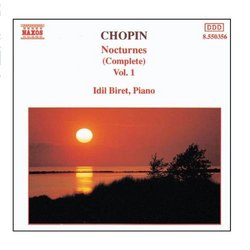| All Artists: Idil Biret Title: Chopin: Nocturnes, Vol. 1 Members Wishing: 0 Total Copies: 0 Label: Naxos Release Date: 7/28/2009 Genres: Special Interest, Pop, Classical Styles: Easy Listening, Forms & Genres, Short Forms Number of Discs: 1 SwapaCD Credits: 1 UPCs: 4891030503564, 730099535625 |
Search - Idil Biret :: Chopin: Nocturnes, Vol. 1
 | Idil Biret Chopin: Nocturnes, Vol. 1 Genres: Special Interest, Pop, Classical
CHOPIN: Nocturnes, Vol. 1 by Idil Biret |
Larger Image |
CD DetailsSynopsis
Album Description CHOPIN: Nocturnes, Vol. 1 by Idil Biret Similar CDs
Similarly Requested CDs
|
CD ReviewsIdel Biret Plays the Chopin Nocturnes Robin Friedman | Washington, D.C. United States | 09/26/2006 (5 out of 5 stars) "For many listeners, the nocturnes are quintessential Chopin, with their dreamlike, reflective character, long, singing melodic lines, exquisite ornamentation, long light runs, trills, turns and arpeggios. Chopin composed nocturnes throughout his creative life. The earliest nocturne with an opus number the nocturne in E minor, opus 72 dates from 1827, Chopin's 17th year, while the final nocturnes of opus 62 were composed in 1846, three years before Chopin's death. Chopin's nocturnes encompass a wide variety of moods and feelings from the dreamy and reserved to the angry and passionate. They are generally in three-part form, with an opening section presenting the themes, a contrasting middle section, which varies widely among the nocturnes, and a recapitulation of the opening material, which also varies a great deal among the works and is sometimes omitted or drastically altered in form. The nocturnes are the most songlike of Chopin's compositions, and an awareness of the long vocal lines is essential to the performer and the listener.
The nocturnes have been recorded many times, but the version by the Turkish pianist Idel Biret is one of the best. Biret recorded the complete works of Chopin for Naxos between 1990 -- 1992, and she received the Grand Prix du Disque Chopin 1995. With so many recordings by better-known artists, Biret still has not received the attention she deserves. She plays the nocturnes with a beatiful singing style, with grace and with reserve. Chopin's work is a combination of romantic feeling and classical form. It is difficult for the performer to avoid the temptation to overinterpret. But Idel Biret allows the music to sing and speak through her, with singing tone, lovely phrasing, light runs, and a measured use of rubato. This CD, and its companion, is a joy to hear. Biret has recorded the nocturnes on two volumes, with this volume, no. 1, including the ten nocturnes from opus 9 (1830-31) through opus 32 (1836--1837) together with two early works without an opus number. The opus 9 nocturnes include the familiar nocturne in E flat major, opus 9. no. 2, which will be familiar to most listeners. Overexposure has made this lovely work sound hackneyed, but Biret gives it a reading of innocence, simplicity, and directness which made me think I was coming to it for the first time. But pay attention to the other two works of the opus 9 set, which are even more beautiful and original and far less known than their companion. The three nocturnes of opus 15 include the well-known opus 15 no. 2 in F-sharp major, with elaborate runs and figurations in its main theme together with the nocturne in g minor, no. 3, which is one of Chopin's easier compositions. I have attempted it, and it is suitable for fellow amateur pianists. The nocturne in C sharp minor, opus 27 no 1 is one of Chopin's finest with a dreamlike opening section that blossoms into a moment of passion before it fades away. Its companion piece in D flat major is frequently performed. It opens with a widely-spaced left hand arpeggio which accompanies a highly melodic and ornamented theme. The two nocturnes of opus 32 include the simple and lyrical no. 1 in B major, and a delicate, dancelike nocturne in A-flat major, no. 2. Chopin's nocturnes are among those rare works which enchant those listeners new to music and which continue to reveal their beauties as one's musical appreciation deepens. Idel Biret's performances on Naxos are an outstanding way to get to know the nocturnes. Robin Friedman" |

 Track Listings (12) - Disc #1
Track Listings (12) - Disc #1






